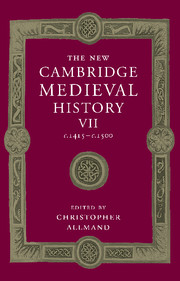Book contents
- Frontmatter
- PART I GOVERNMENT
- PART II ECONOMIC AND SOCIAL DEVELOPMENTS
- PART III SPIRITUAL, CULTURAL AND ARTISTIC LIFE
- 10 Religious Belief and Practice
- 11 Schools and Universities
- 12 Humanism
- 13 Manuscripts and Books
- 14 The Beginning of Printing
- 15 Architecture and Painting
- 16 Music
- PART IV THE DEVELOPMENT OF EUROPEAN STATES
- Appendix Genealogical Tables
- Primary Sources and Secondary Works Arranged by Chapter
- Index
- Frontispiece
- Plate section
- Map 1 European towns in the late Middle Ages
- Map 2 European commerce and trade
- Map 4 Winds and currents facilitating the discoveries
- Map 5 The universities o f Europe in 1400 and 1500
- Map 6 Germany and the Empire
- Map 20 The Roman Orthodox and Ottoman worlds in the fifteenth century
- References
10 - Religious Belief and Practice
from PART III - SPIRITUAL, CULTURAL AND ARTISTIC LIFE
Published online by Cambridge University Press: 28 March 2008
- Frontmatter
- PART I GOVERNMENT
- PART II ECONOMIC AND SOCIAL DEVELOPMENTS
- PART III SPIRITUAL, CULTURAL AND ARTISTIC LIFE
- 10 Religious Belief and Practice
- 11 Schools and Universities
- 12 Humanism
- 13 Manuscripts and Books
- 14 The Beginning of Printing
- 15 Architecture and Painting
- 16 Music
- PART IV THE DEVELOPMENT OF EUROPEAN STATES
- Appendix Genealogical Tables
- Primary Sources and Secondary Works Arranged by Chapter
- Index
- Frontispiece
- Plate section
- Map 1 European towns in the late Middle Ages
- Map 2 European commerce and trade
- Map 4 Winds and currents facilitating the discoveries
- Map 5 The universities o f Europe in 1400 and 1500
- Map 6 Germany and the Empire
- Map 20 The Roman Orthodox and Ottoman worlds in the fifteenth century
- References
Summary
the religious history of the fifteenth century was dominated by the Great Schism. While the immediate repercussions of that schism were prolonged by the conciliar crisis until 1448, its long-term effects would be apparent until the end of the century. For Christian intellectuals there was no anxiety more pressing than repair of the damage caused by these misfortunes and the forearming of the Church against the repetition of a similar catastrophe. This preoccupation was the initial inspiration behind reformatio in capite. Even before the restoration of papal power had nullified those measures agreed by the fathers of the Councils of Constance and Basle, the importance of reformatio in membris had been recognised. Every prelate, every superior of a religious community was expected to regularise the organisation he headed, be it a diocese, a congregation or merely a monastery. It was not only the clergy, both regular and secular, whose faults stood in urgent need of correction; the appeal for endeavour was addressed to all Christian people. It was essential, furthermore, to point out to the faithful the path they should follow. The religious education of the laity had never occupied so high a place among the priorities of those clergy who took their duties seriously.
Keywords
- Type
- Chapter
- Information
- The New Cambridge Medieval History , pp. 203 - 219Publisher: Cambridge University PressPrint publication year: 1998

